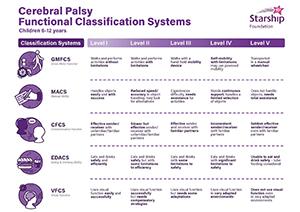A summary of cerebral palsy classifications


Each cerebral palsy classification in detail
You can read about each CP classification in more detail below. Although written for health professionals, some whānau (families) find these helpful.
Gross Motor Function Classification System (GMFCS)
For more information on this classification system, see the GMFCS – E & R: Gross Motor Function Classification System - Expanded and revised and GMFCS E & R between 6th and 12th birthday: Descriptors and illustrations.
Manual Ability Classification System (MACS)
For more information on this classification system, see the Manual Ability Classification System for Children with Cerebral Palsy: 4-18 years.
Communication Function Classification System (CFCS)
For more information on this classification system, see Communication Function Classification System (CFCS).
Eating and Drinking Classification System (EDACS)
For more information on this classification system, see Eating and Drinking Ability Classification System - Algorithm.
